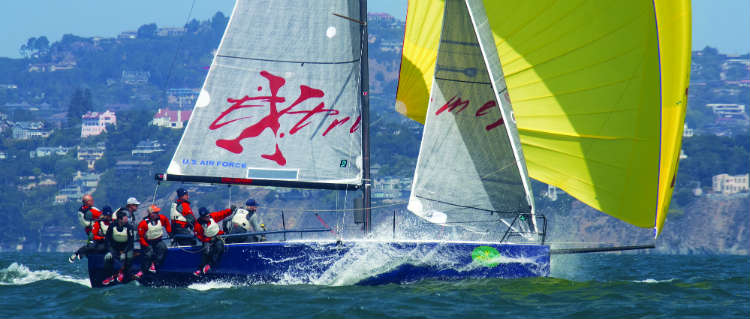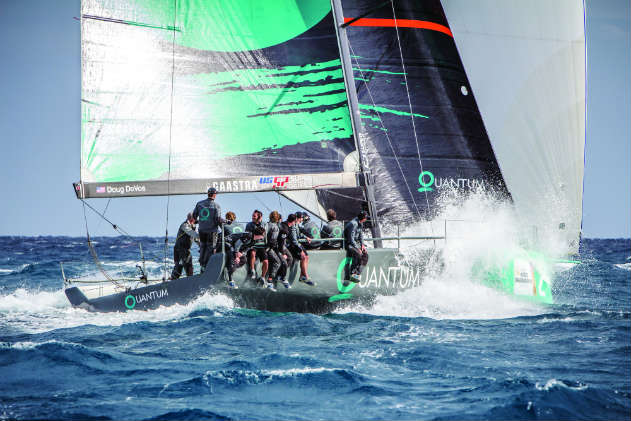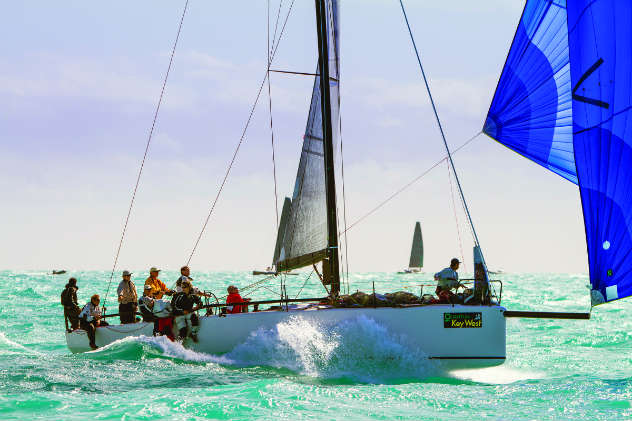Tips for Running in Big Breeze This Fall
I don’t care how experienced a racing sailor you are, I would be surprised if you don’t find your heart in your throat and feel a surge of adrenaline as you get set to bear away on a big breeze run. If you are not just a little bit nervous in heavy air, you may need to check your pulse to make sure you are still alive. Here are a couple of thoughts to help make these moments more exhilarating than painful.
Be deliberate but aggressive
Control on a heavy air run rewards what, at first glance, would seem to be conflicting approaches. First you need to be deliberate. Going off half-cocked with a spinnaker set or gybe is a sure recipe for disaster. The lazy sheet that you forgot to leave enough slack in, or the spinnaker tack that was not tended to as it was pulled out to the end of the pole are no big deal in 10 knots of breeze. You can just grab on the offending line and force it. The same issue in 20-plus knots will end up with the boat on its side or upside down.
Crew members need to review their jobs carefully prior to the top mark to make sure there are no mis-led, cleated, or tangled lines. You have to pay attention to detail, because you only get one chance to get it right.
At the same time, if you are hesitant or timid, you will increase your chances of losing control. If you are going to set a spinnaker, go all in and commit early. Get everyone fired up and ready, because they are going to have to be quicker and more aggressive than usual. They will need to pull the kite up on the sets, or get the mainsail across on the gybes as if their lives depended on it, and then get their weight back where it belongs.
On spinnaker sets there is no rush to trim the sheet
In a set, there is one thing that you don’t want to rush: trimming the spinnaker sheet. If the sail fills before it gets all the way up, you are in for a struggle. Wait until the call of “made” to ensure that the sail is at full hoist. Then, maybe wait a little longer until the crew has time to scramble back and to the high side.
When you trim and the sail fills, you need to be ready with everyone in best position to maintain control. If the bow person is still scrambling around getting organized forward, and if people are off the rail, don’t trim. Just let the sail luff for a bit until you are really ready to launch. You have to have everyone in place, or you will probably crash the moment you trim in.
Driving: the survival angle
Downwind, we always talk about sailing at the optimum angle. In light air, this means sailing higher to create apparent wind, and in moderate air, sailing deeper angles to take advantage of the pressure. In heavy air, there is only one narrow range you can sail in. I call it the survival angle. Sail too high, and you will load up and round up to weather (a normal broach). Try to sail too low, and the boat will want to bear away and round down, potentially all the way into the dreaded accidental gybe. Avoid this at all costs.
To avoid broaching to weather, aggressively bear off as a puff hits. If you get too low and the boat starts to get too flat, start heading up. Ideally, you should try to have the same amount of heel and load on the rudder pretty much all the time, working the boat hard within a narrow range to maintain similar pressure.
Trimmers and the rest of the crew are equally involved with driving. Keep the weight aft. Ease both sails and hike in the puffs to help the driver bear off. Trim and move to leeward if you feel the boat getting too flat and too deep. Don’t ease the spinnaker and boat can’t bear off; over-ease and it will roll to weather and try to round down into a gybe. With a symmetrical spinnaker, trim just before you feel the boat beginning to roll to weather to help dampen the oscillation, and then ease before it rolls to leeward.
Gybes: the moment of truth
The scariest part of any heavy air run will be the gybe. Minimize the potential for disaster, and try to limit it to just one. This is one time where it is okay to go to the lay line. Remember to be deliberate and aggressive. Pick the right moment, have everyone ready, and hit it. The right moment may seem a little counterintuitive. You want to gybe when you are going as fast as possible to minimize the apparent wind and to avoid wallowing; down a wave on a full surf is best.
Once you have committed to the turn, don’t hesitate. You need to turn smoothly but firmly and aggressively from one broad reach to the “survival angle” on the other gybe. You can’t get stuck dead downwind.
It’s okay if the spinnaker is still luffing for the first 30 seconds or so after you come out of a gybe. On a symmetrical boat the pole may not be made. Just let the sheet luff, and take your time getting the pole on. The important thing is to have the mainsail across and be pointing at roughly the right angle to maintain control on the new gybe. The mainsail needs to come across aggressively just at the magic moment when the sail unloads as you pass dead downwind. You can’t trim the sail in slowly to the center as you start the gybe or you will steer the boat and make the driver’s job very difficult. Pull like crazy, or on a small boat grab the sheet purchase and throw, just as you get to dead downwind. Don’t forget to duck.
The takedown
Whew, we made it. Got it set, maintained control, gybed, and stuck the landing. Now do yourself a favor and take down early! The penalty for a late drop in breeze is much higher than getting the sail down a little early. Whatever type of takedown you do, make sure you get the foot of the spinnaker on the boat. That’s the important part. With the foot on the boat all else will follow in good order, and the sail will not end up in the water.
The driver needs to stay at a deep angle to keep the sail behind the mainsail. Don’t head up, even if the mark is beckoning, until the sail is down and under control. Now, breathe a sigh of relief and turn upwind. ~By David Flynn
Questions?: email [email protected]







